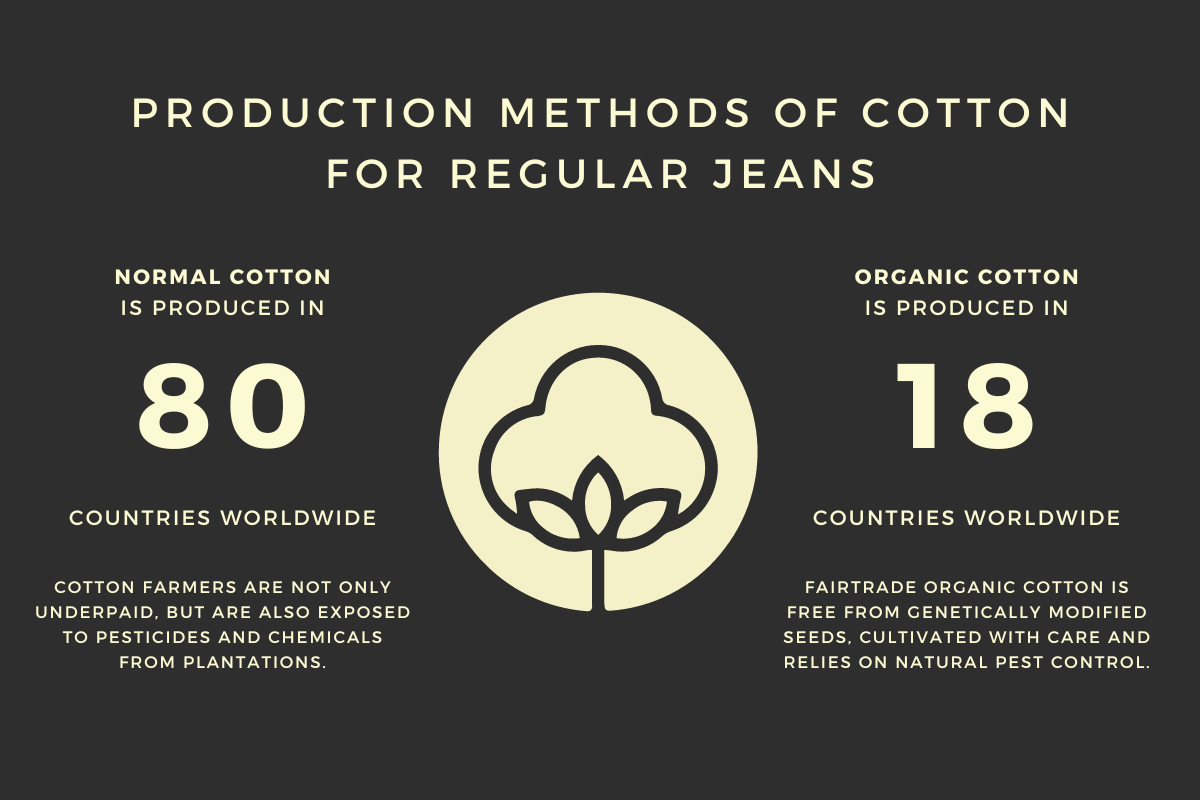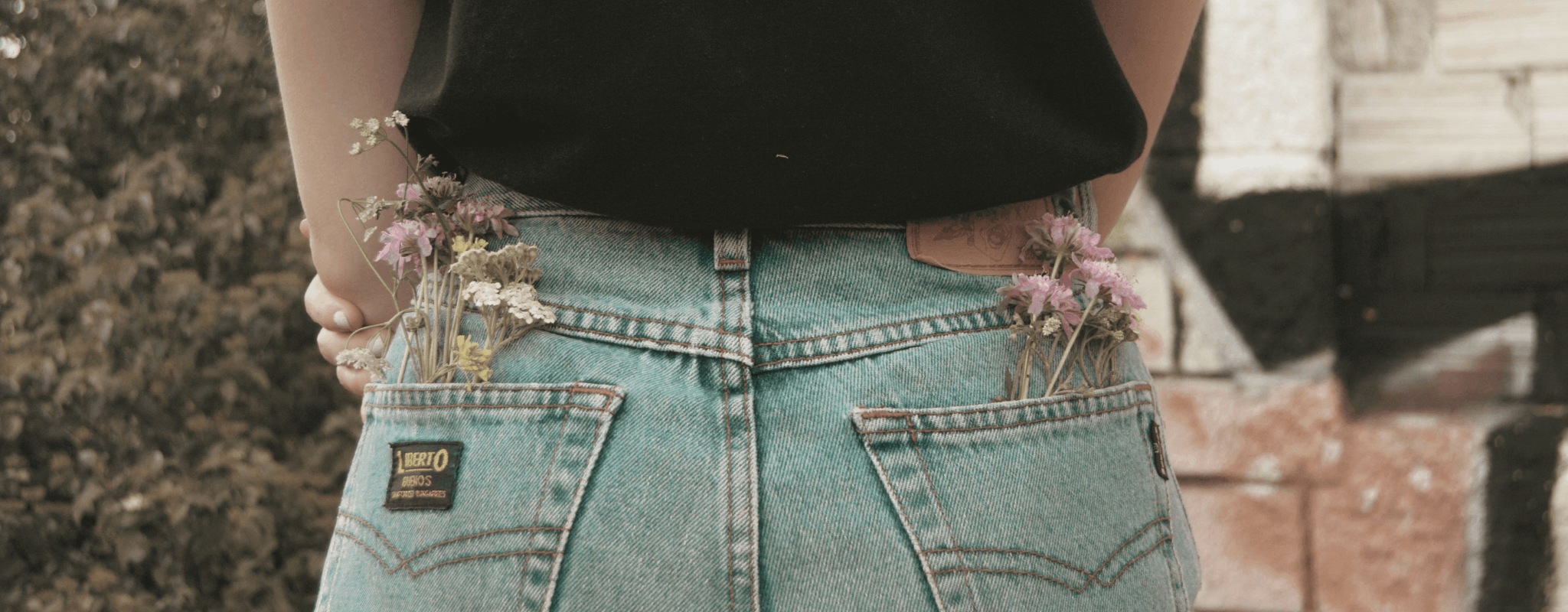Ah, the Blue Jeans. Few trousers carry as iconic a reputation as the Blue Jeans. Yet, as popular as jeans may be, they're also a bit of an environmental troublemaker. Denim, from the cultivation of cotton, the application of pesticides, and the excessive use of water, to the contamination of groundwater due to dyeing chemicals, emerges as a major contributor to pollution in our wardrobes. Here at SANVT, however, we ponder: can jeans be eco-friendly? And if so, what criteria must be met? Discover whether sustainable jeans are utopian or a potential reality.
If you, like us, fall into the category of folks who just can't part with Blue Jeans as a timeless essential, yet yearn to be a conscious consumer caring for the environment and climate, you're undoubtedly in a bit of a pickle. Did you know that jeans, among the garments in your closet, boast one of the largest ecological footprints? The water usage, energy consumption, and chemical deployment in the denim industry are unparalleled in comparison to most other fabrics in fashion.
At SANVT, on a mission to revolutionise fashion sustainably and fairly, we wonder: can jeans be environmentally friendly, or are they fundamentally classified as environmentally irresponsible? Are sustainable jeans a real possibility, or merely a prime example of greenwashing? To answer these questions, let's delve into the reasons why the denim industry ranks among the most environmentally damaging in fashion. Along the way, we'll explore possibilities and factors necessary to make the beloved Blue Jeans more sustainable, ethical, and climate-friendly.

Water Consumption
One of the pivotal factors in calculating the ecological footprint of a fashion product is water consumption. If you've been following us at SANVT or are a more environmentally conscious buyer, you're likely aware that the production of cotton, the raw material for denim, demands massive amounts of water. The dyeing process of jeans also requires substantial water and often leads to water pollution with chemicals. But more on that later. Let's focus on the water consumption in cotton production for now: a whopping 12 billion kilograms of cotton are produced annually in China and India alone. Traditional cotton cultivation requires about 10,000 litres of water per kilogram (some sources even claim between 11,000 and 23,000 litres)! Our beloved jeans consume a staggering 35% of globally produced cotton, making denim the major consumer of cotton in the entire textile industry. Since cotton is quoted as the "dirtiest crop in the world" by the Organic Trade Association (OTA), jeans pose a significant burden on our environment.
To get jeans with significantly lower water consumption, we recommend opting for either vintage jeans, recycled denim jeans, or jeans made from organic cotton. Organic cotton requires up to 91% less water in cultivation compared to conventional cotton!
Pesticides in Cotton Cultivation
However, high water consumption is not the only environmentally harmful factor in cotton cultivation. As cotton grows in monocultures, it is highly susceptible to pests, leading to the use of environmentally damaging pesticides in conventional cultivation. The heavy use of chemical insecticides and pesticides not only harms cotton farmers but also results in the death of bees and other insect species, and the shrinkage of their habitats. Not to mention that monoculture-intensive farming quickly depletes the soils.
Once again, the use of organic cotton is recommended, as certified GOTS organic cotton cultivation is free from genetically modified seeds, relies on gentle cultivation through crop rotation, and practices pest control using natural methods. Jeans made from organic cotton not only consume 91% less water in cultivation but are also gentler and regenerative for soils and the environment.
Find more benefits of organic cotton here.

Unethical Production Practices
While conventional cotton is grown in around 80 countries worldwide, organic cotton cultivation is found in only 18 countries. Most of the rare organic cotton comes from small farmers, whereas the majority of conventional cotton is produced in larger operations, especially in regions with the cheapest labour. The consequence? Unfair and unregulated working conditions. Even though many cotton plantations in the USA are now machine-harvested, hand harvesting is still prevalent to ensure better cotton quality. Nevertheless, most cotton farmers are not only underpaid but also exposed to pesticides and chemicals from the plantation, affecting their health.
To make jeans not only more environmentally friendly but also fair, organic cotton should be sourced ethically. More crucial than Fairtrade labels and organic certifications is the transparency of the brand itself. Look for brands that document their production, all along the production chain, and make that information available for all to see.
Energy Consumption & CO2 Emissions
And since we're talking about transparency, energy consumption and CO2 emissions should also be transparently documented. Jeans production requires a considerable amount of energy for processing cotton, manufacturing yarns and fabrics, dyeing, as well as transporting and storing raw materials and finished jeans. The use of fossil fuels for energy generation in the fast fashion industry results in the release of greenhouse gases contributing to climate change.
To break the cycle and reduce the environmental impact of jeans, we should source our jeans from small businesses striving to work energy-efficiently, shorten transportation routes to reduce CO2 emissions. Ideally, brand-specific emissions should be offset, leading to a carbon-neutral product. Because, let's be honest: no product is truly carbon-neutral and environmentally friendly. Every industrial production has environmental impacts. The least we can do is make sure that the product's ecological footprint is minimised and subsequently compensated through reforestation projects.
Dyeing Process
To achieve the iconic deep blue colour of jeans, the indigo dye must first be made water-soluble. This process involves the use of toxic chemicals and heavy metals such as mercury, cadmium, lead, and copper. These chemicals and heavy metals enter rivers and seas through wastewater, ultimately contaminating groundwater and soil. Often, after dyeing, blue jeans undergo further processes like stone washing, bleaching, or abrasion, involving additional chemicals like potassium permanganate.
In short: Blue Jeans are quite a toxic affair. To obtain a more environmentally friendly pair of jeans, a dyeing process without chemicals and heavy metals should be employed, and a closed water loop should be used, recycling water after the dyeing process instead of releasing it into wastewater.

Reducing the Environmental Impact of Your Jeans
While 80% of emissions arise in the production of clothing, an additional 20% of the ecological footprint occurs after purchase. We are thus responsible for one-fifth of the environmental impact of our clothing – including our jeans. By ensuring proper care, washing less frequently, and repairing minor damages, we can contribute to extending the lifespan of our jeans. After all, it's not just about buying the right sustainable and fair jeans but also about how well you care for your jeans afterwards.
Find tips for sustainable clothing care here, as well as in our Care Guide.
The Perfect Jeans from SANVT - Clean and sustainable denim made possible
Denim stands out as one of the most environmentally damaging fashion items, and we are committed to making a positive change. This means that our jeans are made from post-consumer recycled cotton that can be reinforced with organic Blue Seed fibres. This contributes to the longevity of the cotton - making the end product not only more sustainable, but also higher quality.
Chemical-free dyeing methods
Also in the denim finishing process, we chose only the most environmentally-friendly methods: which is on the one hand using only natural dyes that use plant-based or mineral dyes in the process of applying colour to the textiles. As a result, this method eliminates all hazardous chemicals from our supply chain, because natural dyes do not contaminate air, water and soil, nor dies it harm the environment and wildlife.
Crafted from premium 13.5oz Italian denim - The Perfect Jeans from SANVT.
Commitment to zero waste
Through our innovative production process, we ensure minimal impact on the planet. To fulfil our commitment to zero waste and chemical-free processes, all buttons and rivets are made from 100% recycled metal. With the classic button placket instead of a zip, we also honour traditional denim.
Water recycling
Many processes in the fashion industry, such as dyeing, use large amounts of water. Our factories, including our denim laundry partner, are committed to reducing the amount of waste they are generating in their production and making every effort to ensure that waste is reused, recycled or recovered. This includes reusing water and building a circular water economy. Their commitment to circular water use is demonstrated by the introduction of the innovative 'Eco Wash' production process in 2017. As a result of this new process, they have reduced water consumption by 75%.
Can Jeans Be Eco Friendly: Utopia or Reality?
Our conclusion? A pair of jeans, even with its notorious environmental reputation, can indeed be environmentally friendly under the right conditions. As long as you select a high-quality pair made from organic cotton through fair production from a transparent brand, and confirm that it has been dyed without toxic chemicals and heavy metals in closed water loops, you, as a Slow Fashion Enthusiast, need not carry any guilt. And if you care for your premium jeans afterward, extending their lifespan, the jeans becomes even more sustainable. Good news for all environmentally conscious consumers who have been reluctant to part with their beloved Blue Jeans. Sometimes, you can indeed have it all.


